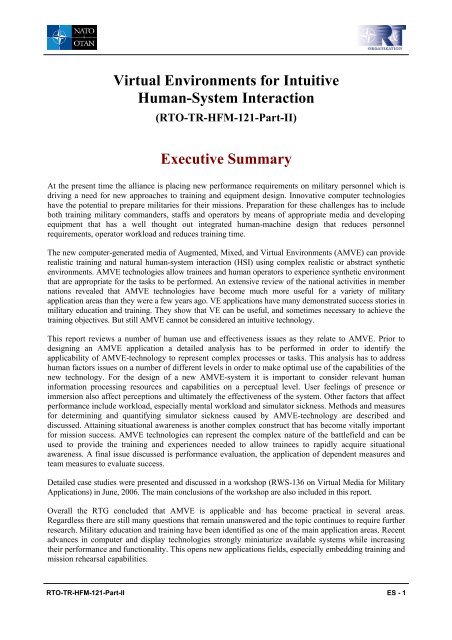RTO-TR-HFM-121-Part-II - FTP Directory Listing - NATO
RTO-TR-HFM-121-Part-II - FTP Directory Listing - NATO
RTO-TR-HFM-121-Part-II - FTP Directory Listing - NATO
You also want an ePaper? Increase the reach of your titles
YUMPU automatically turns print PDFs into web optimized ePapers that Google loves.
Virtual Environments for Intuitive<br />
Human-System Interaction<br />
(<strong>RTO</strong>-<strong>TR</strong>-<strong>HFM</strong>-<strong>121</strong>-<strong>Part</strong>-<strong>II</strong>)<br />
Executive Summary<br />
At the present time the alliance is placing new performance requirements on military personnel which is<br />
driving a need for new approaches to training and equipment design. Innovative computer technologies<br />
have the potential to prepare militaries for their missions. Preparation for these challenges has to include<br />
both training military commanders, staffs and operators by means of appropriate media and developing<br />
equipment that has a well thought out integrated human-machine design that reduces personnel<br />
requirements, operator workload and reduces training time.<br />
The new computer-generated media of Augmented, Mixed, and Virtual Environments (AMVE) can provide<br />
realistic training and natural human-system interaction (HSI) using complex realistic or abstract synthetic<br />
environments. AMVE technologies allow trainees and human operators to experience synthetic environment<br />
that are appropriate for the tasks to be performed. An extensive review of the national activities in member<br />
nations revealed that AMVE technologies have become much more useful for a variety of military<br />
application areas than they were a few years ago. VE applications have many demonstrated success stories in<br />
military education and training. They show that VE can be useful, and sometimes necessary to achieve the<br />
training objectives. But still AMVE cannot be considered an intuitive technology.<br />
This report reviews a number of human use and effectiveness issues as they relate to AMVE. Prior to<br />
designing an AMVE application a detailed analysis has to be performed in order to identify the<br />
applicability of AMVE-technology to represent complex processes or tasks. This analysis has to address<br />
human factors issues on a number of different levels in order to make optimal use of the capabilities of the<br />
new technology. For the design of a new AMVE-system it is important to consider relevant human<br />
information processing resources and capabilities on a perceptual level. User feelings of presence or<br />
immersion also affect perceptions and ultimately the effectiveness of the system. Other factors that affect<br />
performance include workload, especially mental workload and simulator sickness. Methods and measures<br />
for determining and quantifying simulator sickness caused by AMVE-technology are described and<br />
discussed. Attaining situational awareness is another complex construct that has become vitally important<br />
for mission success. AMVE technologies can represent the complex nature of the battlefield and can be<br />
used to provide the training and experiences needed to allow trainees to rapidly acquire situational<br />
awareness. A final issue discussed is performance evaluation, the application of dependent measures and<br />
team measures to evaluate success.<br />
Detailed case studies were presented and discussed in a workshop (RWS-136 on Virtual Media for Military<br />
Applications) in June, 2006. The main conclusions of the workshop are also included in this report.<br />
Overall the RTG concluded that AMVE is applicable and has become practical in several areas.<br />
Regardless there are still many questions that remain unanswered and the topic continues to require further<br />
research. Military education and training have been identified as one of the main application areas. Recent<br />
advances in computer and display technologies strongly miniaturize available systems while increasing<br />
their performance and functionality. This opens new applications fields, especially embedding training and<br />
mission rehearsal capabilities.<br />
<strong>RTO</strong>-<strong>TR</strong>-<strong>HFM</strong>-<strong>121</strong>-<strong>Part</strong>-<strong>II</strong> ES - 1

















